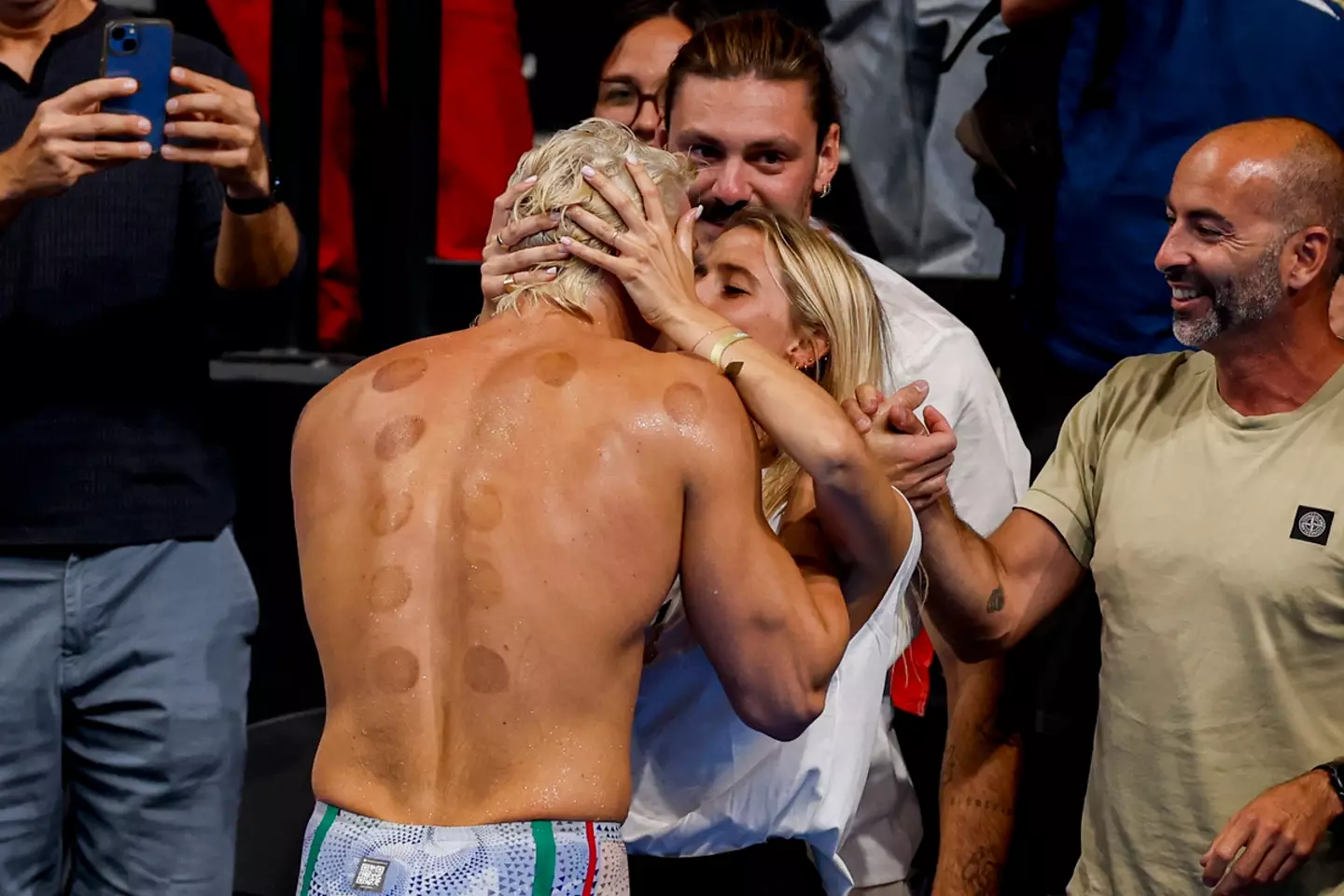
This year’s Olympics are now in full swing and it’s all eyes on the athletes.
From archery and shooting to athletics and gymnastics, there’s all kind of sports taking place across Paris, France, at the moment.
One fan-favorite sport to watch is the swimming, and this year there’s a whopping 854 athletes from 187 different countries competing.
But there’s a common theme you might have spotted with some of the swimmers and that’s the unusual dark red circles they have on their backs.

While it might look like they’ve had a fight with an octopus and lost, there’s a very different reason for the odd markings.
It turns out that the large spots are from cupping therapy – an ancient healing technique that involves placing cups on the skin to create suction and increase blood flow to the area.
The unconventional method is supposed to help with muscle recovery and is used as a type of deep tissue massage.
Some athletes were spotted with cupping therapy bruises back at the Rio Olympics in 2016, and it’s still seemingly popular now.

Gymnast Alexander Naddour told USA Today back in 2016 that cupping was supposedly the ‘secret’ to his health.
He added: “It’s been better than any money I’ve spent on anything else.”
Away from the Games, basketball player Kyle Singler has also praised cupping therapy.
“The bruises do look more intense than what they actually feel like, but the benefit from it is really great,” he previously insisted.
Singler continued to tell Sports Illustrated: “You’re not necessarily getting the immediate response that you might want but over time it does help with recovery and loosening tissue and stuff like that.”
But does cupping therapy actually work according to experts? It’s seems as if the jury’s still out.

According to Harvard Health, some studies have found that cupping might provide some relief for a number of musculoskeletal and sports-related conditions. The quality of this evidence was ‘limited’, however.
Elsewhere a 2022 review found that wet (as opposed to dry cupping) was effective for lower back pain.
While the bruises people get from cupping are pretty gnarly, the therapy is generally seen as safe to practice – even if people aren’t 100 percent on how affective it is.
“Most experts agree that cupping is safe. As long as those treated don’t mind the circular discolorations (which fade over a number of days or weeks), side effects tend to be limited to the pinch experienced during skin suction,” Harvard Health explains.
“It’s quite unusual that cupping causes any serious problems (though, rarely, skin infections have been reported).”
There you have it, folks.
Unveiling the Mystery of a Vintage Relic
Are you the type of person who gets excited by unusual and intriguing finds from the past? Well, you’re not alone! Recently, I stumbled upon a fascinating relic in my country house that has left me completely stumped. I have been racking my brain trying to figure out what it is and how it was used back in the day. My gut feeling tells me it may have something to do with the kitchen. Do you have any ideas? Let’s dive into the mystery together!

In the world of vintage collectibles, there are some items that simply capture the hearts of enthusiasts with their unique charm and nostalgic appeal. One such item is the Classic 1950’s Rubber Bulldog Soda Bottle Stopper. This relic not only serves as a testament to the golden era of soda consumption but also showcases the creativity and innovation of that time.
During the 1950s, the United States underwent a period of remarkable cultural and technological transformation. It was during this decade that soda fountains became popular, and soda bottles with artistic and quirky stoppers took center stage. Among them, the rubber Bulldog soda bottle stopper emerged as a symbol of whimsy and character.
Typically featuring a small rubber replica of a bulldog with a unique facial expression, these stoppers added a playful touch to the classic bottle design. But they were much more than just a functional tool to preserve the carbonation of the soda. They were also clever marketing tactics employed by soda manufacturers to set themselves apart from their competitors.
Every Bulldog stopper was meticulously crafted with great attention to detail. Some had floppy ears, wagging tails, or even movable limbs. The charming design aimed to evoke a sense of companionship and fun for soda consumers, forging an emotional connection with the product.
As time went by, the majority of these unique soda bottle stoppers were discarded or lost, making the remaining pieces increasingly scarce and highly sought after. Today, vintage collectors and soda enthusiasts eagerly hunt for these adorable Bulldog stoppers, valuing their rarity and their link to the past.
If you’re interested in adding one of these delightful pieces to your collection, you can often find them at antique shops, flea markets, and online auctions. Prices may vary depending on the condition, brand, and overall rarity. Some of the most prized Bulldog stoppers even bear the insignias of popular soda brands from the 1950s, making them even more desirable for collectors and fans who want to own a piece of soda history.
The Classic 1950’s Rubber Bulldog Soda Bottle Stopper represents more than just a nostalgic trinket. It embodies an era when soda consumption was a cultural phenomenon and bottle designs were integral to brand identity. Owning one of these stoppers is like holding a piece of American history in the palm of your hand.
To preserve the charm and value of these vintage gems, collectors and enthusiasts take great care in maintaining and displaying their collections. Some choose protective cases or shadow boxes to keep their stoppers safe from dust and damage, while others incorporate them into unique home decor settings, adding a touch of retro charm to modern living spaces.
The Classic 1950’s Rubber Bulldog Soda Bottle Stopper is a delightful relic of the golden era of the soda industry. It has captured the hearts of vintage collectors and soda fans all over the world. These charming stoppers not only represent the creativity and innovation of the 1950s but also offer a glimpse into a time when soda bottles were more than just containers for beverages.
As the years go by, the appeal and collectability of these vintage Bulldog stoppers continue to grow, making them cherished additions to any soda memorabilia collection. Whether displayed in a collector’s cabinet or treasured as a beloved memento, the Bulldog soda bottle stopper will forever be a testament to the joy of soda-drinking and the ingenuity of its era.



Leave a Reply